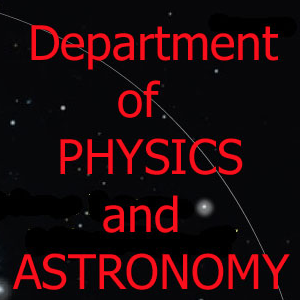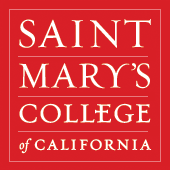Lecturer
Prof. Brian R. Hill, Ph.D. (follow link for additional info including office location and office hours)
Objectives
This course is taken by many students to satisfy part of the Pathways to Knowledge Core Curriculum Requirement. Therefore, particular attention will be paid to the Mathematical and Scientific Understanding goals and outcomes.
Astronomy is a wonderful subject for the sheer pleasure of perusal, and the variety of exotic phenomena in the sky makes it a life-long interest for many people.
However, the goal of the science of astronomy is to understand the great variety of observations in terms of the rather few principles of physics — pretty much all of which can be written down on a single page!
Understanding astronomical observations from physics turns out to be a two-way street. Some of the principles of physics — for example, Newton's Law of Universal Gravitation — or that neutrinos "oscillate", meaning that they change type as they travel — were deduced from astronomical observations in combination with laboratory physics experiments. The relationship of astronomy to physics nowadays is so close that the field is often called "astrophysics" and it can be considered a branch of physics, like condensed matter physics, optical physics and particle physics.
To see some of the observational side of astronomy, the associated laboratory course taught by Prof. Anna Karelina (Physics 91) will have both afternoon labs where physics experiments (on optics, spectroscopy, the Doppler shift) are performed, and observation labs where you will get to see some of the objects that we are studying. Last semester, I taught both the lecture and the lab. There was a single syllabus and the lab grade fed into the overall grade (using the same relative weighting as the course credits). This semester, there is a separate syllabus for the lab, and they will have separate grades.
Necessarily, the class will include some mathematics. This is integral to the scientific method. Every theory of physics that we are confident of, we are confident of precisely because it has been tested quantitatively as well as qualitatively. Theories that only give true/false or qualitative answers historically have often turned out to be very far off in the weeds.
The interplay between astronomical observations, physical principles and quantitative predictions is an excellent example of what the Core Curriculum refers to as the "Mathematical and Scientific Pathway to Knowledge." I intend for you leave the course with a new-found or deepened ability in that — while simultaneously having the fun of learning about some spectacular phenomena.
Texts
- Textbook: The Cosmos: Astronomy in the New Millenium, 4th edition by Jay M. Pasachoff and Alex Filippenko (digital edition is ok if you prefer that to the paperback)
- Workbook: Lecture Tutorials for Introductory Astronomy, Third Edition by Edward Prather et al (workbook has tear-out pages — be sure yours has all pages present and be wary of copies sold on Amazon that are actually used with some pages torn out but being sold as new). Bring the workbook to every class. We will be tearing out pages, stapling them and handing them in.
Outline
- Unit 1: Light, Matter, Energy, Geometrical Optics, Telescopes.
- Textbook Chapters: 2 and 3
- Laboratories: Reflection, Refraction, Lenses
- Note: The Geometical Optics and Telescopes part of this unit will be covered almost entirely within the Physics 91 lab. In class, we will focus on Light, Matter and Energy.
- Unit 2: The Motions of the Earth, the Moon and the Planets.
- Textbook Chapters: 4 and 5
- Laboratory: Projectile Motion.
- Observation Night: Constellations, Moon, Venus, Mars, Saturn.
- Unit 3: The Composition and Properties of The Sun and the Planets.
- Textbook Chapters: 6, 7 and 10
- Laboratory: Spectroscopy
- Observation Lab: Sun.
- Unit 4: The Composition and Lifecycle of Stars, Nova, Supernova and Black Holes
- Textbook Chapters: 11 to 14
- Observation Night: Cluster of Young Stars, Binary Star (consisting of a bluish star and an amber star), Planetary Nebula (e.g., nova remnants, M27 and M57),
- Unit 5: Our Galaxy, Other Galaxies, Galaxy Clusters, The Big Bang, Dark Matter.
- Textbook Chapters: 16 to 19
- Laboratory: Doppler Shift
- Observation Night: Galaxies
Exams and Grading
20% for the in-class assignments, 20% for the at-home assignments, 5% on each unit quiz (approximately 4 quizzes totaling 20%), 15% midterm, 25% final.
The quiz dates will be announced during the associated units. The midterm week as specified by the College is 3/20 to 3/24, so our midterm will be on Thursday 3/23 and we should be well into Unit 3 at that point
Many quiz and exam problems will be multiple choice. To ease my and the teaching assistant's load, many of the in-class and take-home assignments will simply be graded pass-fail. Carefully compare your work with the detailed solutions whenever solutions are given in class or handed out, even if you got full credit. You may have gotten full credit just for effort.
Late in-class and take-home assignments: Accepted for 50% credit. Accepted for full credit if a relevant excuse is stapled to the assignment. Two free "passes" on late homework. No late homework after any quiz or exam. In other words, you must be current by the time of the quiz or exam. "I wasn't in class" is not by itself an excuse. In fact, it is a problem. Athletes who have given me their schedule of away games have a totally valid excuse that I will do my best to accommodate. Keep in mind that missing even one class is like missing half of a week since we only meet twice a week. Expect that there will be a lot to make up. Rely on your classmates for good notes.
Teaching Assistant
Katherine Damiano, a physics major who is also doing her senior independent study in astronomy this semester, is our teaching assistant. Please ask her for help as well as me. I am positive she will be pleased to assist you. Her Saint Mary's username is ked3.
Tutoring
Saint Mary’s has a new STEM Center in Assumption 200 for students studying Science, Technology, Engineering, and Mathematics (STEM). The STEM Center will provide several useful services, including free tutoring in math, chemistry, physics, and biology. The core math/physics hours are 7-9PM and the core chemistry hours are 6-8PM. New hours in each discipline are currently being added, and the updated hours will be posted in the STEM Center: Assumption 200. The STEM Center is also a great space to meet up with your classmates to work on math and science, so stop by anytime between 11AM and 9PM.
They may not be expecting astronomy students, but I am positive that most physics tutors can answer many questions from the introductory astronomy class (or at least will be intrigued by them).
Student Disability Services
Reasonable and appropriate accommodations, that take into account the context of the course and its essential elements, for individuals with qualifying disabilities, are extended through the office of Student Disability Services (SDS). Students with disabilities are encouraged to contact the Student Disability Services Coordinator at (925) 631-4164 to set up a confidential appointment to discuss accommodation guidelines and available services. Additional information regarding the services available may be found on the SDS Office Website.

